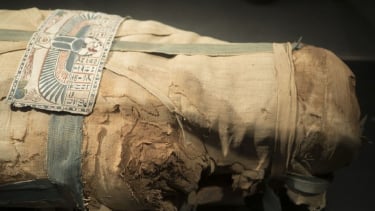The Discovery of Golden Boy Mummy by Digital Scans
- SN Saleem, SA Seddik, M el-Halwagy
VIVA – The Ancient Egyptian mummy named Golden Boy was once a teenager who had a high social stratum. This is known from the results of digital scans.
As the name suggests, he had a layer of gold attached to his body. The mummy had 49 amulets made of gold, diamonds, and precious stones carefully placed in and around his body. There was also other gold placed inside the chest and mouth.
It was first discovered in 1916 in a cemetery used between about 332 and 30 BC at Nag el-Hassay, southern Egypt. The body was fitted with a gilded head mask and chest plate, then placed inside two coffins with an outer Greek-like coffin and an inner wooden sarcophagus.
Despite the lavish burial, the mummy was not looted and sits in the basement of the Egyptian Museum in Cairo. The mummified appearance of the pharaoh's son is now revealed through a new scanning technology.
Ilustrasi mumi.
- Pixabay
In a new study, archaeologists used computerized tomography (CT) scans to study the mummy called Golden Boy. They found that the mummy was a teenage boy who was clearly of high socioeconomic status around 2,300 years ago in ancient Egypt.
At least 21 types of amulets were found in the burial, each representing a different element of Egyptian belief.
A golden tongue was placed inside the mouth to ensure the boy could talk to the gods in the afterlife. While depictions of double eagles and ostrich feathers represented the duality of spiritual and material life.
"Many are made of gold, while some are made of semiprecious stones, burnt clay, or faience. Their purpose is to protect the body and provide vitality in the afterlife," said Dr. Sahar Saleem, first author of the study and a professor at Cairo University's Faculty of Medicine, as quoted by IFL Science, Thursday, February 9, 2023.
"The heart scarab is mentioned in the Book of the Dead chapter 30: it is important in the afterlife during judging the deceased and weighing the heart with the feather of the goddess Maat. The heart scarab silences the heart on the Day of Judgment, so as not to bear witness against the deceased. It is placed inside the body cavity during mummification to replace the heart in case the body loses this organ," Dr. Saleem added.
Not only is the wealth of gold indicative of this teenager being a child of the rich, but his teeth are also in excellent condition with no signs of cavities, tooth loss, or pain.
Research shows that he was about 128 centimeters (4 feet 2 inches) tall. Based on the degree of bone fusion and the fact that his wisdom teeth had not yet appeared, the researchers believe that he was no more than 15 years old.
Typical of ancient Egyptian mummification techniques, her brain had been removed through the nose and her skull pumped with resin. All his vital organs had been removed through incisions, except for his heart which remained in his chest.
On top of all his lavish and undoubtedly expensive jewelry, he was also buried with a simple pair of slippers, “The slippers were probably meant to allow the boy to get out of the coffin. According to the ancient Egyptian Book of the Dead rituals, the deceased must wear white slippers to be pious and clean before reading the verses." concludes.





















